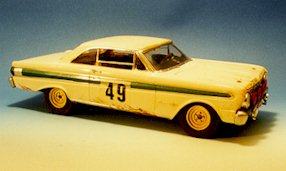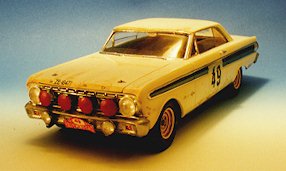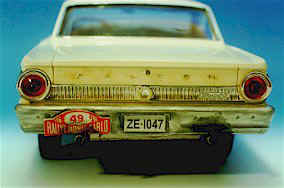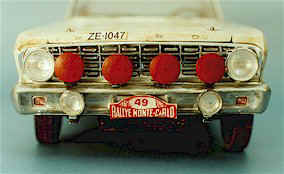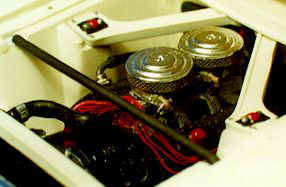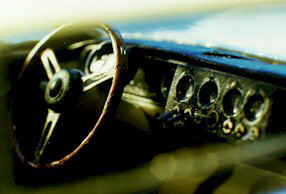Building a 1964 Falcon Futura Sprint
by Göran Kindlund
English translation by Magnus Fridsell
Ford i Monte Carlo
I början på 60-talet beslöt Ford att ”go racing” i stor stil. Det mest kända resultatet är väl 4 LeMans-segrar på ”raken” i slutet av 60-talet med den legendariska Ford GT40. Mindre känt är kanske försöken att vinna Monte Carlo rallyt 1963 och –64.
Ford in Monte Carlo
In the beginning of the 1960s, Ford ”went racing” big style. The most known results are probably winning the LeMans competition for four consecutive years at the end of the 1960s with the legendary Ford GT40. Less known are their attempts at winning the Monte Carlo Rally in 1963 and 1964.
Första året sades en hel del elaka saker, av Europas rallyetablissemang, om Fords uppdykande på arenan. Att de skulle mena allvar med något så löjligt som att åka rally med en stor tung amerikanare var ju uteslutet. Alla visste att rallyn vann man med små smidiga bilar som VW, Porsche, Hundkojor, Saab e t c. Förmodligen var Ford bara ute efter publicitet, och det på de seriösa deltagarnas bekostnad. Illa, illa. Man skall komma ihåg inställningen till proffssport på denna tid. Det var t ex uttryckligen förbjudet med reklam på en tävlingsbil.
In 1963, the European racing establishment wasn’t too impressed by Ford’s entry. Everybody knew that this type of competition was won using a small and light car like a VW, Porsche SAAB or BMC, not a big American one! Most probably publicity was the only thing Ford was after, at the cost of the ones who took things seriously. Worth remembering is that this happened during a time when professional competitors were banned and even a sponsor’s decal on the car was strictly forbidden!
Föraren
Vad alla hade missat var potentialen hos en av förarna, nämligen Bosse Ljungfeldt. Tyvärr fastnade Bosse i en snöstorm, sedan servicebilen kört vilse med snödäcken, redan på uppsamlingsetappen. Så när han kom ner till Monaco låg han på sista plats, p g a transportprickar, innan själva tävlingen ens börjat. Bosse ville ge upp och åka hem men Fordledningen krävde att han fortsatte. Så Bosse bestämde sig för att försöka köra livet ur sin Falcon så fort som möjligt för att få åka hem. Bilen höll emellertid distansen ut och Bosse var snabbast på samtliga fartsträckor och hade vunnit en överlägsen seger om det inte varit för transportprickarna. Istället vann Erik ”på taket” Karlsson en av sina klassiska segrar för Saab.
Året därpå var det ingen som sa något om löjliga PR-jippon. De flesta var nog beredda att sätta en slant på Bosse Ljungfeldt. Men även de franska arrangörerna hade insett allvaret i Fords deltagande, och att en amerikanare skulle erövra förstaplatsen tilltalade inte alls. Så därför hade man uppfunnit en ny regel som innebar att ju större cylindervolym en bil hade ju fortare måste den köra för att vara prickfri. Än en gång var Bosse snabbast på alla fartsträckor men cylindervolymsregeln gjorde att det bara räckte till en andraplats efter Paddy Hopkirk i en Hundkoja.
Det finns många historier i historien. Bl a satte Bosse nya sträckrekord på samtliga fartsträckor. Samma sträckor har använts ända fram till dessa dagar och det sista av Bosses sträckrekord slogs 1982 av Hannu Mikkola i en Audi Quattro. Då skall man betänka att däremellan har det åkts med Porsche Carreror, Renault Alpiner, Lancia Stratosar och BDA Escorter. Alla slagna av Bosse Ljungfeldt i en ’64 Ford Falcon. En annan historia är om FI världsmästaren Graham Hill, som körde en av de andra Fordarna. Han var lite störd av att bli så rejält frånåkt av Bosse.
Det sista specialprovet var ett antal varv på Monacos F1-bana. Hill, som bl a vunnit Monacos Grand Prix året innan, slog vad om en flaska Whisky att här, på Hills hemmaplan skulle Bosse bli frånåkt. Hill fick bjuda på Whiskyn. Bosse var så överlägsen att man ett tag trodde det var fel på tidtagningen. Han var så snabb runt banan att det förde upp honom från femte till andra plats, förbi bl a Erik ”på taket” som fick nöja sig med tredjeplatsen.
The driver
What nobody knew anything about was the potential of one of the drivers, Bosse Ljungfeldt. Sadly, he was stuck in a snowstorm after his service team had lost its bearings with the snow tyres before the rally even had started! When he came to Monaco, he already had so many points due to missing his transport time that there was no use in starting. However, the team forced Bosse Ljungfeldt to drive so he decided on doing his best and managed to win all the speed runs and would have won the whole competition if it hadn’t been for that mistake before the start! Instead, Erik ”på taket” Carlsson (på taket, ”on the roof”) won another one of his classic wins for SAAB.
Next year, nobody said anything about silly PR-coups; rather most people were prepared to bet on Bosse Ljungfeldt! But the French who arranged the competition had also understood how serious Ford were about this and an American car winning the Rally was definitely not to their taste. A new rule was invented, with the effect that the larger the cylinder volume of the car, the faster it had to be driven to win! Also this year, Bosse Ljungfeldt won all the speed runs but the new rule meant that this just resulted in a second place, behind Paddy Hopkirk in a BMC Mini.
There are a further few things to tell around this story. One is that Bosse Ljungfeldt made record times on all the speed runs, the last of which were beaten in 1982 by Hannu Mikkola in an Audi Quattro! Until then, Porsche Carreras, Renault Alpines, Lancia Stratos and BDA Escorts had had their chances, all beaten by Bosse Ljungfeldt in a 64 Falcon! F1 champion Graham Hill, who drove one of the other Fords, felt rather disturbed by being beaten by the fast Swede. The last run was a few laps on the F1-track around Monaco. Hill, who had won the Monaco F1 Grand Prix the year before, bet a bottle of whisky that he should beat Bosse Ljungfeldt here. Hill had to buy the whisky… Bosse Ljungfeldt was so superior that they at one time thought that something were wrong with the time measuring! He was so fast that he climbed from fifth to second places in the total, passing among others Erik ”på taket” who had to be content with third place!
Att bygga en Falcon
Modellen bygger på en gammal AMT-byggsats från 60-talet. Den var inte lätt att få tag i (och inte billig heller) men det största problemet var att få tag i referensmateriel. Bland annat kontaktade jag den gamle motorfotografen LO Magnil, som var på plats i Alperna när det begav sig, och köpte kopior av autentiska foton på bilen. Dessutom omnämndes Fords rallyäventyr i någon bisats här och där i motorlitteraturen och så småningom blev bilden ganska komplett. Den sista, och knepigaste pusselbiten var färgen inom kromlisterna på sidan. Alla bilder var i svartvitt och ingen jag pratade med kom ihåg hur det var. Av en slump hittade jag en färgbild i Vintage Motorsport till sist.
Den gamla byggsatsen var inte särskilt korrekt, kraftigt förenklad och med många väsentliga delar fel. Lustigt nog hade byggsatsen delar till rallyversionen, men både delarna och fotona i byggbeskrivningen var från 1963 års bil som såg helt annorlunda ut (helt annan kaross bl a).
Många delar, motor, växellåda och hela främre delen av chassit med hjulupphängning och innerskärmar, kommer från AMT:s –67 Ford Mustang GT. Vilket faktiskt är helt rätt eftersom Mustangen i praktiken var byggd på Falcon:s bottenplatta. Resten av chassiplattan fick bli en kompromiss, den kommer från AMT:s –66 Chevy Nova. Helt fel sålunda men bättre än den chassiplatta som ingick i byggsatsen.
Såväl andra byggsatser som reservdelslådan fick bidra med delar och några delar fick skratchbyggas (insuget på motorn och delar av instrumentpanelen t ex). Motor, motorrum och inredning har detaljerats på ”vanligt sätt”. En kul detalj är träratten, som faktiskt är av trä och kommer från Replicas & Miniatures Company of Maryland.
Bilen är lackad i orginalkulörerna Wimbledon White och Guardsmen Metallic Blue från MCW Automotive Finishes.
Modelling the Falcon
The kit is an old AMT kit from the sixties. It wasn’t easy to find, neither was it cheap but the biggest problem was the lack of references. I contacted LO Magnil, an old motor sports photographer who was in the Alps during the Rally and bought some original photos of the car. Mentions can also be found of Ford’s racing adventure here and there in the literature and after a while the car was rather complete. The final, and trickiest, part was the colour of the trim between the chromed stripes on the sides. All pictures were black-and-white and nobody seemed to remember the colour but by chance I found a colour picture in Vintage Motorsport.
The old kit wasn’t especially correct; it was very simplified with a lot of major parts wrong. There were parts included for the racing version in the kit but both the parts and the pictures in the instructions were for the 1963 car, which looked completely different with another bodywork.
Lots of parts, including engine, front suspension and chassis originate from the AMT 1967 Ford Mustang GT, which was a rather logical move since the Mustang was built on the Falcon chassis plate. The rest of the chassis plate is a compromise; I borrowed it from an AMT 1966 Chevy Nova. This is uncorrect but anyway better than the original kit chassis!
Both other kits and the scrap box had to supply parts, some were scratch built (inlet manifold and dashboard for instance) and some, like the wooden steering wheel, were bought. (It actually is wood, from Replicas & Miniatures Company of Maryland.)
The car has been painted using the original colours, Wimbledon White and Guardsmen Metallic Blue from MCW Automotive Finishes.
This article was originally published in IPMS Stockholm Magazine in November 1999.

